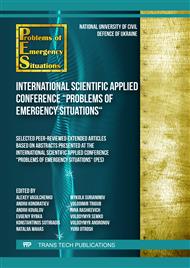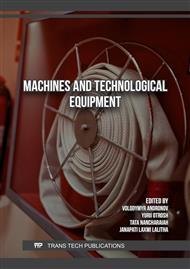[1]
I. Abduragimov, On the problem of extinguishing large fires of solid combustible materials in buildings within the city, Fire and explosion safety, 2 (2012) 75–78.
Google Scholar
[2]
D. Korolchenko, A. Sharovarnikov, Analysis of the dual mechanism of flame extinguishing. Fire and Explosion Safety. Special issue, (2014) 114–123.
Google Scholar
[3]
D. Dubinin, K. Korytchenko, A. Lisnyak, I. Hrytsyna, V. Trigub, Improving the installation for fire extinguishing with finelydispersed water, Eastern-European Journal of Enterprise Technologies, 2 (2018) 38–43.
DOI: 10.15587/1729-4061.2018.127865
Google Scholar
[4]
A. Semko, M. Beskrovnaya, S. Vinogradov, I. Hritsina, N. Yagudina, The usage of high-speed impulse liquid jets for putting out gas blowouts, Journal of Theoretical and Applied Mechanics, 3 (2014) 655–664.
Google Scholar
[5]
A. Semko, O. Rusanova, O. Kazak, M. Beskrovnaya, S. Vinogradov, I. Gricina, The use of pulsed high-speed liquid jet for putting out gas blow-out. International Journal of Multiphysics, 9 1 (2015) 9–20.
DOI: 10.1260/1750-9548.9.1.9
Google Scholar
[6]
Y. Abramov, O. Basmanov, J. Salamov, A. Mikhayluk, Model of thermal effect of fire within a dike on the oil tank. Naukovyi Visnyk Natsionalnoho Hirnychoho Universytetu, 2 (2018) 95–100.
DOI: 10.29202/nvngu/2018-2/12
Google Scholar
[7]
R.I. Shevchenko, V.M. Strelets, V.M. Loboichenko, A.V. Pruskyi, O.N. Myroshnyk, G.V. Kamyshentsev, Reviewof up-to-date approaches for extinguishing oil and petroleum products SOCAR Procee dings, (2021) 169–174.
DOI: 10.5510/ogp2021si100519
Google Scholar
[8]
S.M. Shakhov, S.A. Vinogradov, The efficiency of the compressed air foam, water and gel extinguishing agent on the standard model fire class A. Safety & Fire Technology, 1(56) (2020) 154–160.
DOI: 10.12845/sft.55.1.2020.10
Google Scholar
[9]
D. Dubinin, K. Korytchenko, A. Lisnyak, I. Hrytsyna, V. Trigub, Numerical simulation of the creation of a fire fighting barrier using an explosion of a combustible charge, Eastern-European Journal of Enterprise Technologies, 6 10–90 (2017) 11–16.
DOI: 10.15587/1729-4061.2017.114504
Google Scholar
[10]
M. Gurbanova, V. Loboichenko, N. Leonova, V. Strelets, Effect of inorganic components of fire foaming agents on the aquatic environment, Journalof the Turkish Chemical Society, Section A: Chemistry, 7 (3) (2020) 833–844.
DOI: 10.18596/jotcsa.785723
Google Scholar
[11]
A. Kireev, D. Tregubov, S. Safronov, D. Saveliev, Study insulating and cooling roperties of the material on the basis of crushed foamglass and determination of its extinguishing characteristics with the attitude to alcohols, Materials Science Forum, 1006 MSF, (2020) 62–69.
DOI: 10.4028/www.scientific.net/msf.1006.62
Google Scholar
[12]
I.F. Dadashov, V.M. Loboichenko, V.M. Strelets, M.А. Gurbanova, F.M. Hajizadeh, A.І. Morozov, About the environmental characteristics of fire extinguishing substances used in extinguishing oil and petroleum products, SOCAR Proceedings, 5 (2020) 79–84.
DOI: 10.5510/ogp20200100426
Google Scholar
[13]
I. Dadashov, A. Kireev, I. Kirichenko, A. Kovalev, A. Sharshanov, Simulation of the insulating properties of two-layermaterial, Functional Materials, 25 4 (2018) 774–779.
Google Scholar
[14]
K. Korytchenko, O. Sakun, D. Dubinin, Y. Khilko, E. Slepuzhnikov, A. Nikorchuk, I. Tsebriuk, Experimental investigation of the fire-extinguishing system with a gas-detonation charge for fluid acceleration, Eastern-European Journal of Enterprise Technologies, 3 5–93 (2018) 47–54.
DOI: 10.15587/1729-4061.2018.134193
Google Scholar
[15]
C. Tao, F. Xue-cheng, B. Zhi-ming, X. Jian-jun, W. Rong-ji, Experimental Study on the Extinguishing Efficiency of Compressed Air Foam Sprinkler System on Oil Pool Fire, Procedia Engineering, 211 (2018) 94–103.
DOI: 10.1016/j.proeng.2017.12.142
Google Scholar
[16]
R. Dong–Ho, L. Jang–Won, K. Seonwoong, Class B Fire–Extinguishing Performance Evaluation of a Compressed Air Foam System at Differen Air–to–Aqueous Foam Solution Mixing Ratios, Applied Science, 6 (191) (2016) 2–12.
DOI: 10.3390/app6070191
Google Scholar
[17]
C. Jing–yuan, X. Mao, Experimental Research of Integrated Compressed Air Foam System of Fixed (ICAF) for Liquid Fuel, Procedia Engineering, 71 (2014) 44–56.
DOI: 10.1016/j.proeng.2014.04.007
Google Scholar
[18]
Z. Yang, T. Chen, C. Hu, Z. Bao, A study of fire extinguishing performance of compressed air foam on rim seal fire for floating roof tanks, Fire Science and Technology, 39 (5) (2020) 641–645.
Google Scholar
[19]
W. Kun, F. Jun, R. Hassan, M. Shanjun, L. Xuqing, W. Jingwu, Z. Yongming, A theoretical and experimental study of extinguishing compressed air foam on an n-heptane storage tank fire with variable fuel thickness, Process Safety and Environmental Protection, 138 (2020) 117–129.
DOI: 10.1016/j.psep.2020.03.011
Google Scholar
[20]
M. Zhao, X. Ni, S. Zhang, W. Cao, Y. Guan, C. Liang, X. Wang, Improving the performance of fluoroprotein foam in extinguishing gasoline pool fires with addition of bromo fluoro propene, Fire Mater, 40 (2016) 261–272.
DOI: 10.1002/fam.2284
Google Scholar
[21]
L. Zhaoqian, Z. Hongqing, Z. Jinlong, Z. Yilong, Experimental Research on the Effectiveness of Different Types of Foam of Extinguishing Methanol / Diesel Pool Fires, Combustion Science and Technology, (2022).
DOI: 10.1080/00102202.2022.2125306
Google Scholar
[22]
Y. Wang, Y. Zhen, X. Gao, L. Xiao, Experimental study on fire suppression and burn resistance of compressed air foam, Fire Science and Technology, 41(11) (2022) 1542–1546.
Google Scholar
[23]
X. Zhang, Z. Bao, L. Jing, Y. Chen, Experimental study on fire extinguishing with alcohol-resistant compressed air foam, Fire Science and Technology, 39(9) (2020) 1271–1273.
Google Scholar
[24]
A. Kamlyuk, O. Navrotskiy, A. Grachulin, Fire extinguishing by compressed air foam systems, Journal of Civil Protection, 1 (2017) 44–53.
DOI: 10.33408/2519-237X.2017.1-1.44
Google Scholar
[25]
S. Shakhov, S. Vinogradov, O. Larin, Analysis of world's compressed air foam systems,Emergency Situations: Prevention and Liquidation, 1(2017) 50–58.
Google Scholar
[26]
Patent RU №2456037; A62C5/02 (2006.01) / Kruger Tino(DE), Dorau Günther (DE)/– reciv.: 2008151529/12 at 24.04.2008; publ.: 20.07.2012 (72); Advanced Compressed Air Foam Technology.
Google Scholar
[27]
Mobile installation fire extinguisher natisk-35. URL: https://specialauto.ru/natisk-35bl
Google Scholar
[28]
POLY MOBILE SL50 On a transport frame. URL:https://firesafecambodia.com/wp- _content/uploads/2015/08/PC715_POLY-MOBILE- SL50_DB_EN.pdf
Google Scholar
[29]
Rosenbauer. URL: https://www.rosenbauer.com › int › products › ca
Google Scholar
[30]
HNE. Products. [Electronic resource].URL: https://www.hne.ag
Google Scholar
[31]
S. Shakhov, A. Kodrik, O. Titenko, S. Vinogradov, Improving the efficiency of using compressed air foam systems. Problems of fire safety, 48 (2020) 127–131.
DOI: 10.4028/www.scientific.net/msf.1006.11
Google Scholar
[32]
S. Shakhov, A. Kodrik, O. Titenko, S. Vinogradov, Consideration of thermodynamic processes formation of compressed-air foam in desing compressed air foam systems,Materials Science Forum, 1006 (2020) 11–18.
DOI: 10.4028/www.scientific.net/msf.1006.11
Google Scholar
[33]
S. Shakhov, S. Vinogradov, A. Kodrik, O. Titenko, Development of mathematical apparatus for designing compressed air foam generation systems,Scientific Bulletin of UNFU, 30(3) (2020) 111–115.
DOI: 10.4028/www.scientific.net/msf.1006.11
Google Scholar
[34]
S. Vinogradov, S. Shakhov, A. Kodryk, O. Titenko, O. Parkhomchuk, Mathematical modeling of gas-liquid flow in compressed air foam generation systems, Technology Audit and Production Reserves, 4/3(54) (2020) 29–35.
DOI: 10.15587/2706-5448.2020.210375
Google Scholar
[35]
DSTU 3734–98. Fire equipment. Fire extinguishers are portable, General technical requirements, K.: State Standard of Ukraine, (2000) 26 p.
Google Scholar



